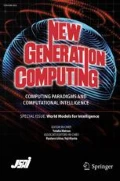Abstract
This study considered an information presentation method to help customers make a concept-articulation type of purchase. When customers follow the concept-articulation type of thinking, they only have vague requirements and try to make a gradual clarification of what they really want through the interaction with salesclerk(s). Skillful salesclerks can communicate with their customers appropriately to discover an opportunity for bringing the customers to their concept-articulation, which often leads to a successful sale. Based on the observations from our analysis of these human behavior in actual purchase activities, we constructed a system called S-Conart (Concept Articulator for Shoppers) to support the concept-articulation type of purchase. The user study conducted using S-Conart shows that using a different method of presenting information can cause a change in the user’s mental world, which is also observed in a real-life shopping situation, although in a different form. The result of this user study suggests the possibility of chance discovery by customers themselves, which is expected to be useful for building support systems for concept-articulation type of shoppers.
Similar content being viewed by others
References
Boden, M.,The Creative Mind: Myths and Mechanisms, Basic Books, 1991.
Gero, J. S., “Computational Models Creative Design Processes,” Artificial Intelligence and Creativity (Dartnall, T., ed),Studies in Cognitive Systems, 17, pp. 269–281, Kluwer Academic Publishers, 1994.
Hori, K., “Concept Space Connected to Knowledge Processing for Supporting Creative Design,”Knowledge-based Systems, 10, 1, pp. 29–35, 1997.
Ishino, Y., Hori, K. and Nakasuka, S., “Concept Development of Consumer Goods Utilizing Strategic Knowledge,”Knowledge-based Systems, 13, pp. 417–427, 2000.
Nakakoji, K. and Fischer, G., “Intertwining Knowledge Delivery, Construction and Elicitation,”A Process Model for Human-computer Collaboration in Design, Knowledge-based Systems Journal: Special Issue on Human-computer Collaboration, 8, 2–3, pp. 94–104, Butterworth-Heinemann Ltd, 1995.
Pu, P. and Faltings, B., “Enriching Buyers’ Experiences: the SmartClient Approach,” inProc. of ACM CH12000, 2000.
Shoji, H. and Hori, K., “Chance Discovery by Creative Communicators Observed in Real Shopping Behavior,” (Terano, T. et al., eds.), JSAI2001 Workshops, LNAI2253, pp. 462–467, 2001.
Shoji, H. and Hori, K., “Strategy Emergence from Human-computer Interaction,”Strategic Knowledge and Concept Formation, III, (Gero, J. S. and Hori, K., eds.), pp. 87–99, 2001.
Sugimoto, M., Hori, K. and Ohsuga, S., “A Method to Assist Building and Expanding Subjective Concepts and its Application to Design Problems,”Knowledge-based Systems, 7, 4, pp. 233–238, 1994.
Suwa, M., Purcell, T. and Gero, J., “Macroscopic Analysis of Design Processes Based on a Scheme for Coding Designers’ Cognitive Actions,”Design Studies, 19, 4, pp. 455–483, 1998.
Underhill, P., “Why We Buy: The Science of Shopping,” Touchstone Book, 1999.
Zhang, J., “The Nature of External Representation in Problem Solving,”Cognitive Science, 21, 2, pp. 179–217, 1997.
Author information
Authors and Affiliations
Corresponding author
Additional information
Hiroko Shoji: She is an associate professor in the Department of Information and Communication Sciences at Kawamura Gakuen Women’s University, and also a doctoral student in the Department of Advanced Interdisciplinary Studies at the University of Tokyo. She received her B.S. in mechanical engineering in 1989 and her M.Eng. in mechanical engineering and engineering synthesis in 1991 from the University of Tokyo. Her current research interests include creativity in real life and chance discovery. She was awarded a Research Promotion Award from Japanese Society for Artificial Intelligence (JSAI) in 2000.
Koichi Hori, D.Eng.: He received his B.Eng, M.Eng, and Dr.Eng. degrees in electronic engineering from the University of Tokyo, in 1979, 1981, and 1984, respectively. In 1984, he joined National Institute of Japanese Literature, where he developed AI systems for literature studies. Since 1988, he has been with the University of Tokyo. He is currently a professor with Department of Advanced Interdisciplinary Studies, the University of Tokyo. From September 1989 to January 1990, he also held a visiting position at University of Compiegne, France. His current research interests include AI technology for supporting human creative activities, cognitive engineering and Intelligent CAD systems. Professor Hori is a member of IEEE, ACM, IEICE, IPSJ, JSAI, JSSST, and JCSS.
About this article
Cite this article
Shoji, H., Hori, K. Creative communication for chance discovery in shopping. NGCO 21, 73–86 (2003). https://doi.org/10.1007/BF03042327
Received:
Issue Date:
DOI: https://doi.org/10.1007/BF03042327




